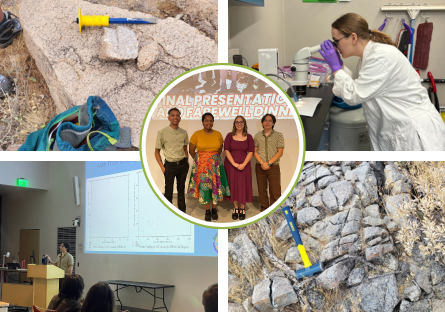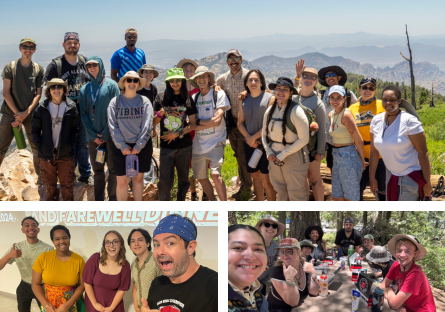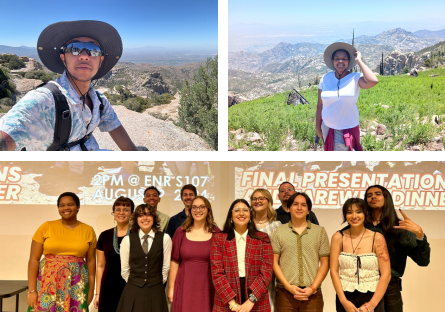


Mountain Lions Generously Compensated During 8-Week Research Opportunity
When Estrella Mountain Community College (EMCC) Geology Professor Zachary Kovach told his students about an eight-week paid geoscience research opportunity at the University of Arizona (U of A) this summer, they wanted in. To be considered for U of A’s Clouds to the Core program, they had to submit a personal statement of interest, their transcripts, and a letter of recommendation. Only 12 students total from community and tribal colleges across the southwest would be accepted. Four Mountain Lions make the cut.
“I don’t think it is common to get four students like we did,” Professor Kovach said. “EMCC represented 33% of the students!”
Clouds to the Core introduces students from two-year colleges to geoscience career opportunities and the opportunity to transfer to the U of A to earn a bachelor’s degree in geosciences after earning their associate degree at EMCC. Although this is the program’s second year, the idea began in 2020 when the U of A’s Drs. Andy Cohen and Kau Thirumalai, reached out to Professor Kovach, wanting to tailor a program to undergraduate/community college-level students.
The program begins with a two-week orientation and project introduction period at the U of A, followed by five weeks of research. Each student is assigned a different research topic and mentors. During the last week of the program, students present their work to their peers, lab mates, mentors, friends, and family. Each student is compensated with free lodging, a $600-per-week stipend, and a $100-per-week food allowance.
“When setting this program up, it was important to discuss who our students are and the fact that most of them are working in some capacity,” Professor Kovach said. “So in order to get these students to go to the U of A for eight weeks or so, they also needed to be compensated. The stipend and room and board are what make this possible for a lot of the students.”
The compensation aspect was especially intriguing to EMCC Environmental Engineering major Justice Gonzales, whose research project involved determining the ocean’s role in the southwest climate.
“I was very excited when I found out I’d been accepted into the program because it meant I would have the security to not have to work other jobs during the summer and be able to learn and further my educational goals,” Justice said. “It was very reassuring to find out that somebody saw enough value in me to compensate me well and let me know my worth going forward.”
Becca Lord agreed.
“I think it's cool that we got paid because I feel like most programs don’t pay their participants,” Becca said. “And it was really nice that we didn’t have to worry about room and board, so we could just focus on our research.”
When Becca found out she’d been accepted into the Clouds to the Core program, she was getting ready to graduate from EMCC with her Associate in General Business. She had very little geoscience background.
“When I found out I’d been accepted, I cried,” Becca said. “I was overwhelmed and in disbelief because I didn’t think a business major with no experience in geoscience would be accepted.”
Becca’s research project, titled “Temporal Constraints on the Cat Mountain Supervolcanic Sequence,” focused on determining if two different types of rocks found within the Tucson Mountain range were equal in age. Becca and her mentors spent a couple of days in the field collecting samples and then running them through various equipment in the lab.
“I was not familiar with any of the lab equipment going into this program, but I was provided with training by my supportive mentors,” Becca said. “I never felt alone in my work, and I knew there was always someone to ask questions of.”
The program gets the students out of their comfort zone, but is very mindful about it, Professor Kovach said.
“They have their faculty mentor as well as undergraduate mentors who went through the program last year,” Professor Kovach said. “So there really is a lot of support, not only research/academically, but also support on campus life, living on their own, having someone to talk to, etc.”
Becca’s research ended up revealing that rocks found in several locations within the Tucson Mountains were of vastly different ages — some 2 million years apart.
“We’re not sure why that is,” Becca said. “It will take more research to determine that. But it tells us that the source of the Cat Mountain Tuff, which is igneous and extrusive — ejected material in an eruption — had to have come from somewhere else, outside of the Tucson Mountains.”
With an Associate in General Business already under her belt, Becca is now working on an Associate in Science with an Emphasis in Geology. Once she completes that degree, she will transfer to the U of A and have the opportunity to continue her research.
“This makes me even more excited since my research left me with so many questions,” Becca said.
Once she transfers to the U of A, she will pursue a bachelor’s in Geoscience and Society, something she is even more confident about now that she has completed the Clouds to the Core program.
“This program provided me with the resources and connections necessary to make the transfer to the U of A, but also to form friendships with people I’ll be transferring with and studying alongside.”
Taiton Grey might be one of them. The dual major — Automated Industrial Technology and Mechanical Engineering — will graduate from EMCC in 2026, transfer to Arizona State University for a bachelor’s in Mechanical Engineering, and then most likely head on down to the U of A for a master’s and PhD in Sustainability and Agriculture. Taiton said the Clouds to the Core program absolutely influenced his choice of major and decision to pursue geoscience.
“For my own personal reasons, I want to get my bachelor’s in engineering because I just like knowing how things work,” Taiton said. “And the jobs I want either want an engineering degree or a geoscience degree so that’s why I am doing my master’s and PhD in the geosciences.”
Taiton, who grew up in Virginia, said his research project, “Sea Level Rise Acceleration After 2010,” hit especially close to home.
“I felt like it was the perfect project for me because my focus was on the acceleration along the Atlantic and Gulf Coasts and most of my family is dispersed along those regions,” he said. “I was even able to use actual photographs from beaches back home in my final presentation.”
Students in the program were assigned roommates and housed in one of the U of A’s dormitories. When they weren’t conducting their own research, they got to know each other, hanging out, sharing meals, and participating in group activities such as hikes and a visit to Biosphere 2. Eden Toliver, an EMCC Anthropology major, said the most rewarding aspect of being in the program was getting to make so many new friends.
“It was great getting to spend time with the other participants,” Eden said. “I hope to stay in touch with most of the other students. I know I'll be staying in touch with Justice since I see Justice a lot around school already.”
Eden’s research project, “Crystal Settling Timescales in Magma,” involved determining how crystals forming and settling in magma affect the properties of the magma, changing how it will erupt. Most of Eden’s time was spent in the lab, filming different-sized acrylic spheres falling into water and oil and analyzing the footage to ascertain their velocity.
“I was definitely busy once I got started on my project,” Eden said. “I still had time to do other things, but I was occupied for most of the day.”
While students grew more comfortable in their research endeavors, they were all a little nervous during their presentations, but Professor Kovach, who drove down to Tucson to support them, said they all did an amazing job.
Dr. Cohen said the program gives students a huge leg up in terms of confidence and readiness to attend a STEM B.S. or B.A. program.
“Our goal specifically is to encourage transfer to the U of A and our Geosciences Department,” Dr. Cohen said. “We provide 6 units of upper-division credit at no cost to the students for those who decide to attend the U of A and major in Geosciences.”
EMCC has transfer partnerships with the University of Arizona, Arizona State University, Northern Arizona University, Grand Canyon University, and more than 40 public, private, and online institutions across the country. Learn more at https://www.estrellamountain.edu/university-transfer.
The application for the 2025 Clouds to the Core summer program will open in the fall. Students can learn more and apply by going to https://c2c.geo.arizona.edu/ and clicking on “Apply Now.”